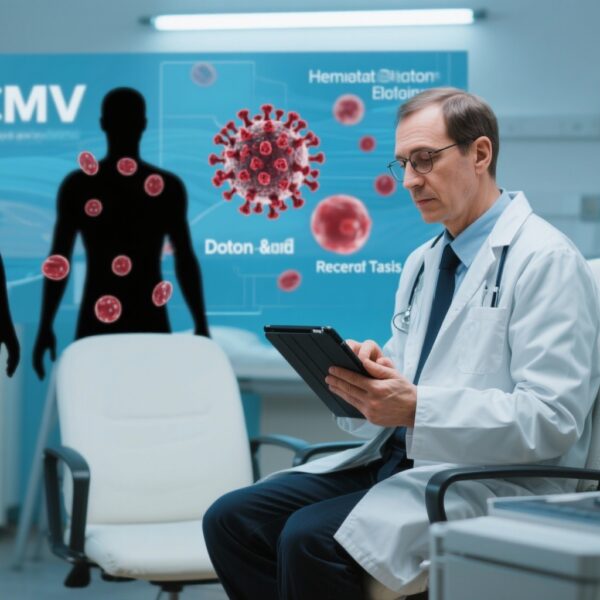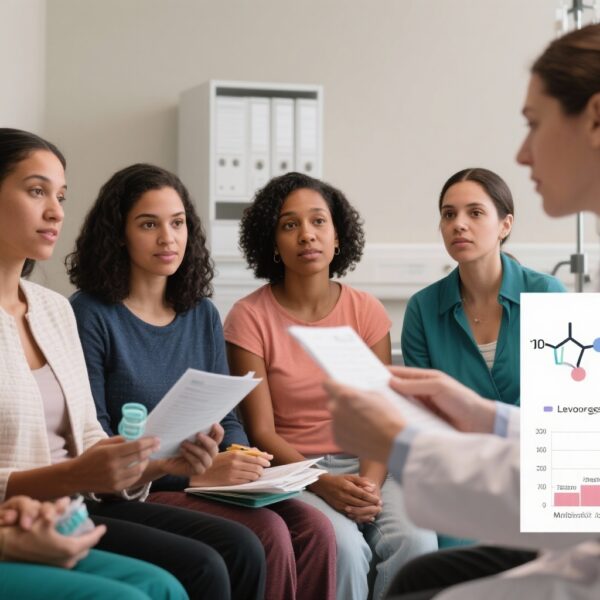Highlights
– Allogeneic HCT activity recovered sharply in 2023 after COVID-era declines, with the largest growth in patients aged 65–74 years (CIBMTR 2013–2023).
– Matched unrelated donors remain the single largest allogeneic donor source (45%), but haploidentical and mismatched unrelated donor use has risen as PTCy-based GVHD prophylaxis has been widely adopted.
– Use of post‑transplant cyclophosphamide (PTCy) is now ubiquitous in haploidentical transplants and has rapidly expanded in mismatched donor transplants and in reduced‑intensity conditioning settings for matched donors.
– Autologous HCT volumes are stable-to-declining while commercial CAR‑T therapy use has grown steeply since 2017, notably for lymphoma and increasingly for multiple myeloma.
Background
Hematopoietic cell transplantation (HCT) and cellular therapies, including chimeric antigen receptor T-cell (CAR‑T) therapy, are central to curative and disease‑modifying strategies for hematologic malignancies and certain nonmalignant disorders. National registry data provide a comprehensive window into real‑world practice, evolving standards (donor selection, conditioning intensity, GVHD prophylaxis), and outcomes. The Center for International Blood and Marrow Transplant Research (CIBMTR) compiles annual summaries across the United States; the 2013–2023 dataset (with CAR‑T captured from 2016 onward) offers important insights into post‑pandemic recovery, diffusion of novel prophylactic strategies, age and donor‑type shifts, and survival trends (Spellman et al., 2025).
Study design and methods (report overview)
The CIBMTR report summarizes all first autologous or allogeneic HCTs and first CAR‑T therapies performed in the U.S. and reported to the registry between 2013 and 2023 (CAR‑T from 2016–2023). The analysis presents relative proportions by donor type, patient age groups, disease indication, GVHD prophylaxis strategies, and race/ethnicity. Causes of death were tabulated by frequency and overall survival estimated using the Kaplan–Meier method. New disease‑risk stratification aligned acute myeloid leukemia (AML) cases to the European LeukemiaNet (ELN) cytogenetic risk categories and myelodysplastic syndromes (MDS) to the Revised International Prognostic Scoring System (IPSS‑R), enabling contemporary risk‑aligned assessments. The report is descriptive and registry‑based; formal multivariable causal inference analyses are not the primary focus of the slide set.
Key findings
Overall activity and patient demographics
Allogeneic HCT volumes rose substantially in 2023, reversing the reduced activity observed during the COVID‑19 pandemic years. The increase was most pronounced in the 65–74‑year age group, reflecting expanding indications, improved supportive care, and use of lower‑intensity conditioning regimens that make HCT feasible in older adults.
Donor source trends
In adults, matched unrelated donors (MUDs) remain the leading allogeneic donor source at roughly 45% of transplants, followed by haploidentical related donors (Haplo; 21%), matched related donors (MRD; 18%), mismatched unrelated donors (MMUD; 12%), and cord blood (Cord; 3%). Notable dynamics include:
- Rapid growth in MMUD use, with a doubling since 2020. Registry analysts attribute much of this shift to broader acceptance of PTCy as an effective GVHD prophylaxis across mismatched donors.
- In pediatrics, haploidentical donors overtook matched related donors in 2023 as the most frequent source—underscoring changing pediatric practice and donor availability.
GVHD prophylaxis: the PTCy era
Post‑transplant cyclophosphamide (PTCy) has become the dominant GVHD prevention strategy in haploidentical transplant settings (>90% use since 2016). Adoption is now widespread beyond haploidentical grafts:
- MMUD transplants have rapidly shifted to PTCy (≈82% in 2023).
- In MRD and MUD transplants, PTCy use differs by conditioning intensity: non‑myeloablative/reduced‑intensity conditioning (NMA/RIC) cases have higher PTCy uptake (58% for MRD, 64% for MUD) compared with myeloablative conditioning (MAC) settings (43% and 46%, respectively). The report notes this reflects emerging practice patterns and trial‑derived standards of care.
- In pediatric practice, calcineurin inhibitor (CNI) ± other agents remains most common for MRD (88%) and MUD (68%) HCT, although PTCy is already common in pediatric haploidentical transplants (~68% in 2023). For MMUD pediatric transplants, alternative strategies including abatacept and ex‑vivo T‑cell depletion/CD34 selection retain considerable use (28% and 17% respectively).
Autologous HCT and CAR‑T therapy
Autologous HCT volumes showed a slight decline during the reporting interval, a trend reported in recent years as targeted therapies and cellular therapies re‑shape treatment paradigms for lymphoma and plasma‑cell disorders. Conversely, CAR‑T therapy use has increased rapidly since the first commercial approvals in 2017. By 2023, CAR‑T indications were concentrated in lymphoma (≈45% of CAR‑T activity) and multiple myeloma (≈16%), reflecting expanded approvals and off‑trial adoption.
Outcomes—survival and causes of death
Three‑year overall survival improved significantly when comparing transplants performed in 2017–2022 versus 2012–2016: for allogeneic HCT, 3‑year OS increased from 55.8% to 62.1%; for autologous HCT, from 79.6% to 82.6% (P < .001 for both comparisons). Notwithstanding survival gains, relapse remained the dominant cause of mortality beyond day 100 after HCT across settings: primary disease accounted for roughly 45–47% of deaths after allogeneic HCT and 60–79% after autologous HCT, with pediatric proportions similar in direction.
Interpretation and clinical implications
The 2013–2023 CIBMTR data highlight several convergent trends that are reshaping transplant practice in the United States.
First, the rebound in allogeneic HCT rates—especially in older adults—underscores expanding eligibility and improved tolerability of HCT. Wider use of NMA/RIC regimens, improved infection prophylaxis and supportive care, and better patient selection likely contribute.
Second, PTCy has catalyzed a pragmatic expansion of donor options. Its high efficacy in haploidentical settings has translated into increased comfort using PTCy in MMUDs and in matched donors with NMA/RIC conditioning. Practically, this increases access to curative HCT for patients lacking an HLA‑matched relative or unrelated donor and may simplify donor selection algorithms.
Third, CAR‑T therapy’s rapid adoption is reshaping treatment sequencing for relapsed/refractory lymphoid malignancies and increasingly for plasma‑cell disorders. The interplay between CAR‑T and HCT—whether CAR‑T is used as a bridge to transplant, an alternative to HCT for some indications, or a post‑HCT relapse salvage—will be an important research and policy question.
Finally, despite improved survival overall, relapse remains the dominant cause of post‑HCT mortality, indicating that gains in transplant safety and GVHD control must be paired with better disease‑control strategies: optimized conditioning, pre‑ and post‑HCT disease eradication strategies (targeted agents, maintenance therapy), donor lymphocyte infusions, enrollment in relapse prevention trials, and incorporation of cellular therapies post‑transplant where indicated.
Limitations of the registry data
Registry analyses have important strengths—breadth, real‑world generalizability, and the ability to capture temporal trends—but also inherent limitations:
- Heterogeneity in center reporting and potential under‑reporting; reporting completeness may vary by center and region.
- Potential confounding by indication: shifts in donor selection or prophylaxis may reflect changes in patient risk profiles, center expertise, or access rather than causal treatment effects.
- Limited granularity for some variables (for example, detailed disease‑specific biologic features, minimal residual disease status, or uniform post‑HCT maintenance practices) that influence relapse risk and survival.
- Shorter follow‑up for more recent cohorts and for CAR‑T recipients limits conclusions about long‑term outcomes.
Research and practice gaps—priorities going forward
- Prospective comparative studies (randomized or well‑designed observational comparative‑effectiveness trials) are needed to define the relative benefits of PTCy versus alternative GVHD prophylaxis strategies across donor types and conditioning intensities.
- Integration studies to determine optimal sequencing of CAR‑T and HCT for specific indications (e.g., multiply relapsed lymphoma; high‑risk myeloma) and the role of CAR‑T as consolidation post‑HCT merit priority.
- Focused relapse‑prevention trials—post‑HCT maintenance, targeted therapy, and cellular strategies—are needed because relapse remains the major cause of late mortality.
- Equity analyses to identify persistent disparities in access to HCT/CAR‑T by race, ethnicity, socioeconomic status, and geography, and design interventions to close those gaps.
Expert commentary
Practicing transplant physicians will recognize the dual message of the CIBMTR report: progress in safety and access (reflected in improved survival and broader donor options) alongside an enduring unmet need to reduce relapse. The rapid, real‑world uptake of PTCy beyond haploidentical settings reflects both pragmatic success and the need for continued comparative evaluation. Similarly, CAR‑T’s expansion creates opportunities to reduce reliance on autologous HCT for some indications, but also complicates cross‑platform comparisons. Multidisciplinary care pathways, early clinical trial enrollment, and continued registry surveillance are essential.
Conclusion
The 2013–2023 CIBMTR summary documents important, practice‑altering trends: recovery and growth of allogeneic HCT activity post‑pandemic (notably among older adults), widespread diffusion of PTCy with attendant increases in mismatched‑donor use, modest declines in autologous HCT, and rapid growth in CAR‑T therapy. These changes correlate with improved short‑ to intermediate‑term survival, but relapse remains the primary driver of late mortality. Future efforts should focus on relapse prevention strategies, rigorous comparative studies of GVHD prophylaxis across donor types, and equitable access to curative and cellular therapies.
Funding and clinicaltrials.gov
The CIBMTR operates with support from the National Institutes of Health, the National Marrow Donor Program/Be The Match, and other partners; the referenced report was authored and published by CIBMTR investigators (Spellman et al., 2025). Specific trial identifiers referenced conceptually in practice changes (e.g., contemporary BMT CTN studies informing PTCy use) can be located via ClinicalTrials.gov for details of trial design and results.
References
1. Spellman SR, Xu K, Oloyede T, et al. Current Activity Trends and Outcomes in Hematopoietic Cell Transplantation and Cellular Therapy – A Report from the CIBMTR. Transplant Cell Ther. 2025 Aug;31(8):505-532. doi:10.1016/j.jtct.2025.05.014.
2. Döhner H, Estey E, Grimwade D, et al. Diagnosis and management of AML in adults: 2017 ELN recommendations from an international expert panel. Blood. 2017;129(4):424-447. (European LeukemiaNet recommendations.)
3. Greenberg PL, Tuechler H, Schanz J, et al. Revised International Prognostic Scoring System for Myelodysplastic Syndromes (IPSS‑R). Blood. 2012;120(12):2454-2465.
Author note
This article synthesizes the CIBMTR 2013–2023 activity report and places its major findings into a clinical and research context for practicing clinicians and policy professionals. Readers should consult the full CIBMTR manuscript and supplementary materials for detailed tables, subgroup analyses, and methods.



